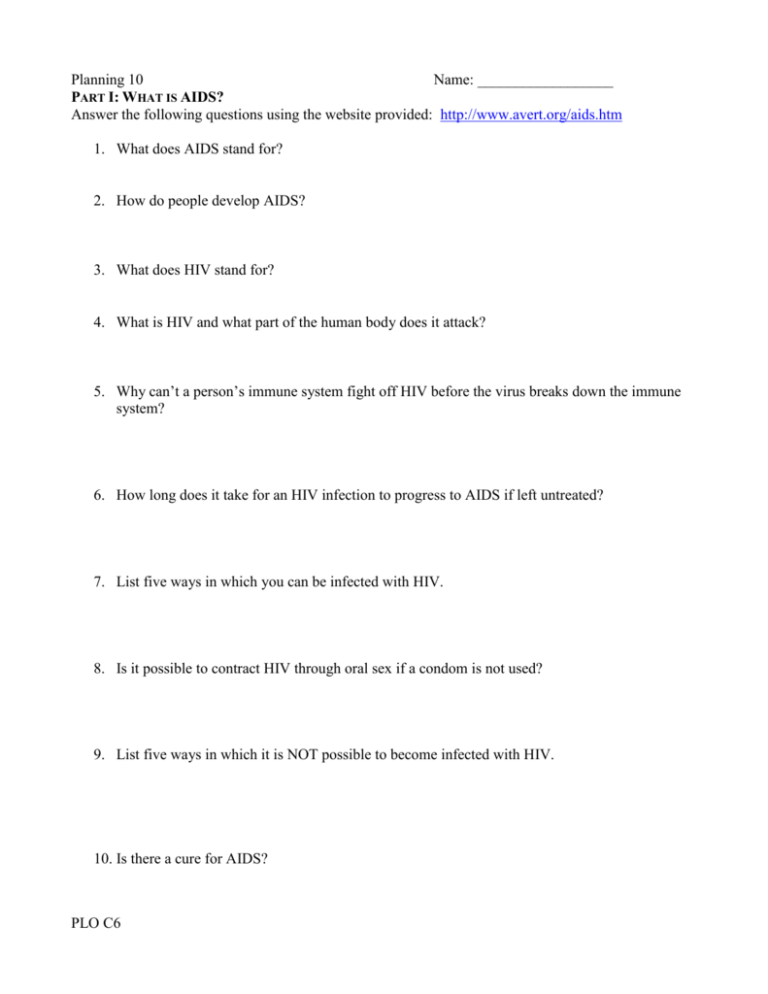
Planning 10
Name: __________________
PART I: WHAT IS AIDS?
Answer the following questions using the website provided: http://www.avert.org/aids.htm
1. What does AIDS stand for?
2. How do people develop AIDS?
3. What does HIV stand for?
4. What is HIV and what part of the human body does it attack?
5. Why can’t a person’s immune system fight off HIV before the virus breaks down the immune
system?
6. How long does it take for an HIV infection to progress to AIDS if left untreated?
7. List five ways in which you can be infected with HIV.
8. Is it possible to contract HIV through oral sex if a condom is not used?
9. List five ways in which it is NOT possible to become infected with HIV.
10. Is there a cure for AIDS?
PLO C6
PART II: TRANSMISSION & GETTING TESTED
Answer the following questions using the websites provided:
http://www.avert.org/aids.htm
http://www.avert.org/testing.htm
1. The standard HIV test looks for antibodies in a person’s blood. What are antibodies?
2. If a person has antibodies to HIV in their blood, they must have been infected with HIV. What
are the two exceptions to this rule?
3. How long after infection does it take for antibodies to HIV to become detectable?
4. The time between infection and the development of antibodies is called the _____________
period.
5. During the period mentioned above, is it still possible for someone to pass on the HIV virus
even though it cannot be detected in their blood?
6. If you engage in a high-risk activity such as having unprotected sex or drug use with shared
needles, should you be tested for HIV immediately? Explain.
7. If you are worried that you might have been exposed to HIV but don’t seem to have any
unusual symptoms, do you still need to be tested?
8. List four reasons why it is important to get tested for HIV.
PLO C6
PART III: PREVENTION – EDUCATION IS THE BEST PREVENTION!
Answer the following questions using the website provided: http://www.avert.org/prevent-hiv.htm
1. List three ways someone can eliminate or reduce their risk of becoming infected with HIV
during sex.
2. List three efforts that might reduce the risk of infection of HIV through blood by injecting drug
users.
3. List three efforts that might reduce the risk of infection of HIV through blood transfusions.
4. List two efforts that might reduce the risk of infection of HIV through activities involving blood
such as tattooing or medical procedures.
5. The best way to prevent mother to baby infection is to reduce HIV infection rates in women and
to prevent unwanted/unplanned pregnancies. Once an HIV positive woman does become
pregnant, what are three efforts that might reduce the risk of infection for the baby during
pregnancy, labour and breast feeding?
6. What does “safe sex” mean?
7. What does “safer sex” mean?
PLO C6
PART IV: STATISTICS
Answer the following questions using the website provided: http://www.avert.org/canada-aids.htm
Look at statistics on positive HIV tests and AIDS diagnoses for Canada.
1. Overall, have AIDS diagnoses in Canada been increasing or decreasing over the past 10 years?
2. After learning the basics about this disease during this assignment, why do you think is this the
case?
3. Overall, have positive HIV test reports in Canada been increasing or decreasing over the past 10
years?
4. Do these statistics change your answer for the previous question? What do you think accounts
for the difference in these two sets of statistics?
PLO C6






